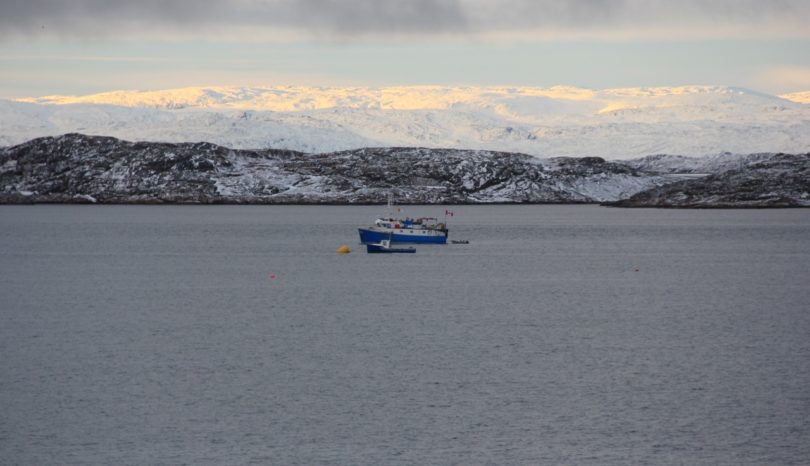Unlike other regions of the planet where overfishing has severely depleted stocks, the Canadian Arctic has had little exposure to industrial-scale commercial fisheries. Though there have been localized stock depletions in the recent past, Arctic waters provide an abundance of fish, marine mammals and seabirds.
Fish are a primary source of food for the 53 coastal communities of Inuit Nunangat in Canada’s Arctic, and residents rely on small-scale, community-based fisheries. In much of the North, Arctic char is second only to caribou meat as staples in people’s diets.
Melting Ice, Increased Access
Warming oceans and melting ice have allowed increased industrial access that could pose risks to the fragile ecosystem. Climate change has also begun to force certain fish species to move north in search of colder water, and these migrations could displace established Arctic species, disrupting already stressed food webs.
Canada’s fishery policies are based on precautionary approaches and discourage the issuance of permits for large-scale commercial fishing in areas where the available science is insufficient to ensure a sustainable catch. Yet applications to Fisheries and Oceans Canada (DFO) for new exploratory fisheries have increased in recent years. That raises the question of how to safeguard a marine ecosystem that would be very slow to recover or might not recover if overfished. The Arctic is attracting an expanding and complex mix of industrial shipping, frontier fishing and trawling that could destroy key fish populations and important habitat.
A New Approach to Frontier Fisheries Management
Ecosystem-based plans are a new tool to manage frontier Arctic fisheries and protect their natural bounty for future generations. These plans place fisheries within the much broader context of the surrounding ecosystem, take into account industrial and human pressures on habitat and seek to ensure that fisheries do not unduly disrupt those systems. This approach does not ignore or reject commercial activities but assigns priority to sustainable employment for northern communities with the following ecological safeguards:
- Defined sustainable harvest and peer-reviewed fisheries model
- Established ecosystem productivity levels
- Cold-water coral habitat protections
- Nearshore aggregation areas and narwhal feeding areas
The Beaufort Sea’s Ecosystem-based Fisheries Plan
In 2009, the Inuvialuit Regional Corporation, the Inuvialuit Game Council and the Fisheries Joint Management Committee decided that small-scale community-based fisheries in the Beaufort Sea should be encouraged, while large-scale offshore operations should not be permitted.
As a result, DFO signed a final agreement in 2014 to prevent the start of commercial fishing in over 831,000 square kilometres of the Canadian Beaufort. This groundbreaking agreement between the Canadian government and Inuvialuit prevents industrial fishing until scientists and local communities can ensure it will be sustainable. They will assess each request for a permit by the following criteria:
- A guarantee that marine mammal populations will not be affected
- Scientific evidence must show surplus biomass or enough fish to support a sustainable catch
- Does not disrupt or negatively affect subsistence harvests of any kind
- Provides Inuvialuit meaningful economic opportunities
Steps Toward Sustainable Arctic Fisheries
Here are key developments in recent years:
- 2014: A precautionary commercial fishing management plan for the Beaufort Sea is created with the support of the Inuvialuit Settlement Region, scientists, partners and key government agencies. It prevents large-scale industrial fishing until scientific research and management measures can ensure a sustainable catch.
- 2015: The Canadian government approves a fishing management plan covering 971,000 square kilometres that protects the continental shelf along Baffin Island from bottom trawling.
- 2015: Canada and five coastal Arctic countries sign an international fisheries declaration in Nuuk, Greenland, that protects 2.8 million square kilometres of high seas in the central Arctic Ocean. The declaration says those nations will not fish in the area until scientific research supports a sustainable catch and until there is a regulatory system in place. In addition to Canada, the other signatories are Norway, the United States, the Russian Federation and the Danish Kingdom (comprising Denmark, Greenland and the Faroe Islands).
- 2017: Canada, Russia, the United States, Greenland, Norway, China, South Korea, Iceland, Japan and the European Union reach agreement for a binding international Arctic fisheries accord to prevent the start of commercial fishing in the Central Arctic Ocean and conduct a joint program of scientific research in the region.
2017: The Canadian government creates seven new marine refuges in the eastern Arctic totaling 145,000 sq. km that protects cold water coral and other sensitive habitat by banning fishing gear that touches the ocean floor.
Opportunities
Oceans North supports the following initiatives for Arctic fisheries:
- Ecosystem-based fisheries that are developed and managed by Inuit and support Inuit culture and food security
- New partnerships among Arctic communities, scientists and governments that use traditional knowledge and scientific research to prevent unsustainable large-scale industrial fishing
- Innovative incentives to limit the expansion of existing Arctic fisheries into new ice-free areas, including placing a higher value on previously fished areas than unfished frontier areas
Learning from the hard lessons of industrial overfishing, precautionary fisheries planning can protect the long-term sustainability of irreplaceable marine ecosystems for the benefit of northerners.

